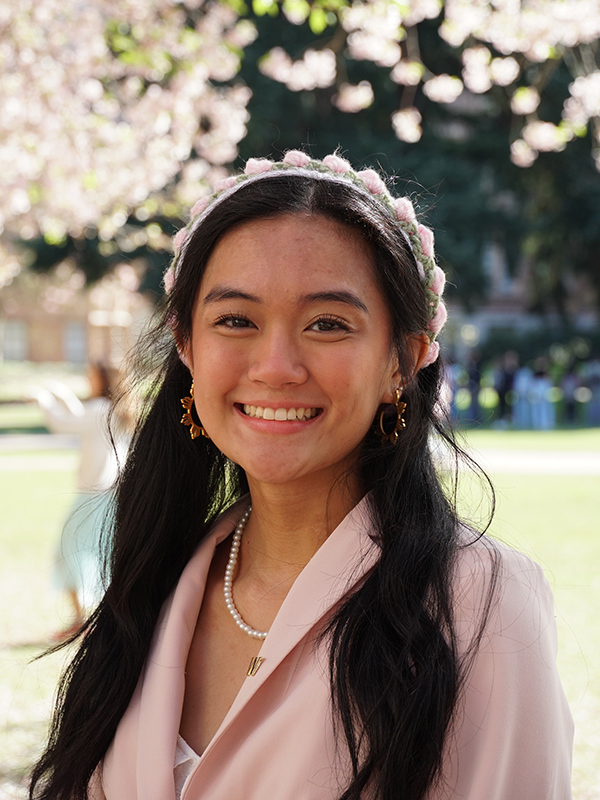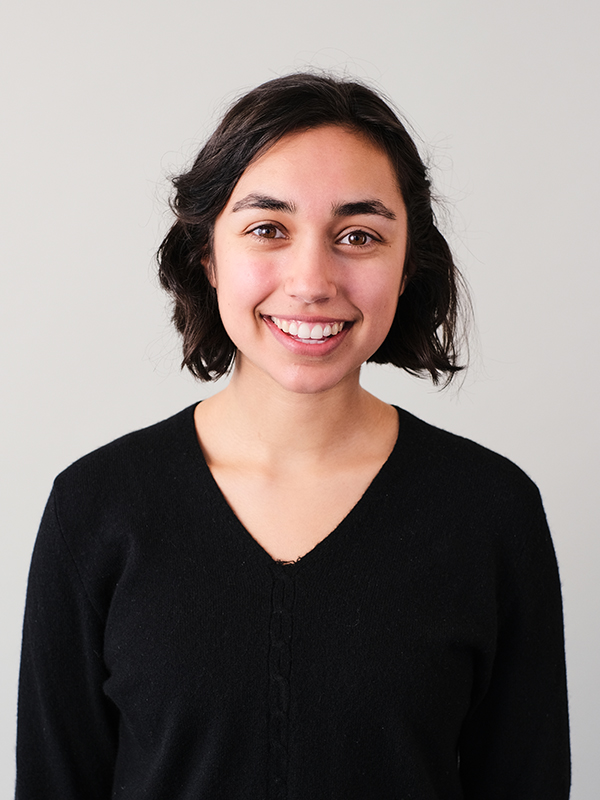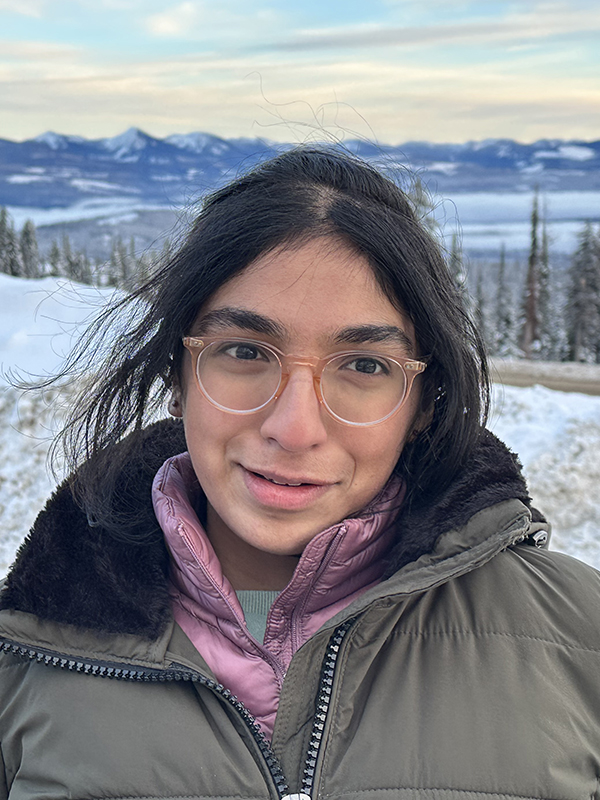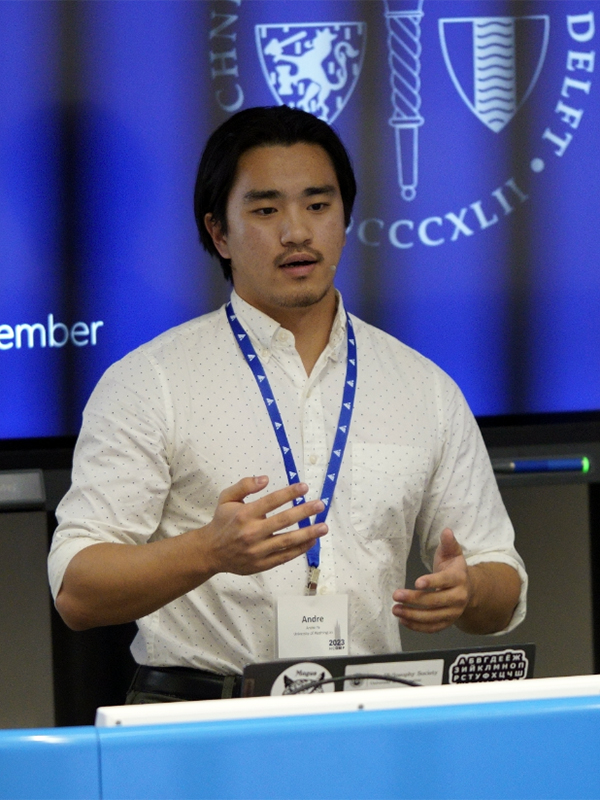Earlier this year, the Computing Research Association honored a select group of undergraduate students from around the country who have made notable contributions to the field through research. The CRA Outstanding Undergraduate Researcher Awards competition historically has been good to Allen School students. To the four most recent honorees — award winner Kianna Bolante, finalists Claris Winston and Andre Ye, and honorable mention recipient Nuria Alina Chandra — even more rewarding than national recognition is realizing the impact their contributions can have on individuals and communities in Washington and beyond.
Kianna Bolante: Empowering students to think critically about technology
As a member of multiple groups underrepresented in computing, CRA award winner Kianna Bolante is always on the lookout for ways to blend her curiosity about technology with a desire to create positive social change.
“This mindset has guided me towards opportunities aligning with my values,” she said.
In addition to multiple service and leadership roles on campus, those opportunities have included research projects spanning accessibility, robotics and social computing. Bolante’s interest in the latter led her last year to pursue what is arguably her most high-profile work to date: a comprehensive social computing curriculum aimed at guiding middle and high school students to consider the different ways they and others interact with technology. Her interest in the project was inspired in part by her realization that, although students spend increasing amounts of their time online, most secondary education curricula do not prepare them to engage meaningfully on the topic of how people interact with digital technologies.
“A community’s core comes from how its individuals interact with each other, and social computing systems are a vital network affecting how humans build community daily — even more so due to the COVID-19 pandemic,” observed Bolante. “Yet, despite its pervasive influence, social computing topics are not explicitly taught in secondary-level courses in the U.S.”
Keen to bridge that gap, Bolante teamed up with professor Amy Zhang and members of the Allen School’s Social Futures Lab to develop six educational modules that teachers could incorporate, in whole or in part, into their classroom lesson plans. The modules, which covered topics spanning online behavior, machine learning and bias, misinformation and more, offered a combination of lecture content, hands-on activities and resources to support in-class discussion as well as personal reflection. After creating the curriculum, Bolante proceeded to travel around to Seattle-area schools, where she shared the lesson content with more than 1,400 students and their teachers.
“That she has impacted so many young people is not only a show of her strong ability to lead and communicate but also the dedication she brings to educating young people,” Zhang said. “Kianna took modest expectations for the project and blew them out of the water!”
That dedication would lead Bolante to lead-author a paper reporting on the results of pre- and post-lesson surveys. She presented at the Association for Computing Machinery’s Technical Symposium on Computer Science Education (SIGCSE ‘24) in March.
“This area of study affects us all through our constant use of collaborative systems and social technologies, such as social networking platforms, but we don’t all experience them all the same way,” Bolante noted. “We incorporated culturally responsive pedagogy in our design to help students connect their learning to their identities. A constant theme is to encourage students to think critically on the positives and negatives of social technology designs.”
Zhang and her Allen School colleague Maya Cakmak were delighted, but not surprised, that the CRA chose to recognize Bolante for her contributions with an Outstanding Undergraduate Researcher Award. Bolante had enrolled in Cakmak’s introductory research seminar as a sophomore, following an initial foray into research via a project analyzing language preferences in relation to disability and her work with Zhang through the DUB REU program during her first year at UW. Although the seminar is designed for those with no previous research experience — and Bolante already had a published paper to her name, after the aforementioned analysis appeared at the International ACM SIGACCESS Conference on Computers and Accessibility (ASSETS ‘22) — she hoped to hone her independent research skills and connect with other like-minded students.
Bolante subsequently returned the favor by serving as a teaching assistant in the next offering of the course, sharing her knowledge and experience. In addition, she has participated in extensive outreach activities as a member of various student groups on campus in addition to her continued engagement with middle and high school students. She is also blending her interests in education pedagogy, social computing and accessibility in her work with another Allen School professor, Kevin Lin, to incorporate content that reflects a functional understanding of different physical, sensory and cognitive abilities into the school’s own Data Structures & Algorithms course. Her many contributions inspired her inclusion in the 2024 class of the Husky 100, a designation that recognizes students who are making the most of their time at UW.
“Kianna has contributed to so many research projects. She is a quick learner and resourceful in solving problems and adapting to the needs of each project. She is also a clear communicator who truly cares about her audience,” said Cakmak. “It is no wonder she has given so many talks and is asked to be on so many panels — and she never passes on an opportunity to use her voice to empower others.”
Nuria Alina Chandra: Decoding the genetic basis of disease
Ever since she first set foot on campus, Nuria Alina Chandra wanted to try her hand at research into the mechanisms of disease. But the difficulty she initially encountered trying to break into a lab — figuratively speaking, of course — galvanized her interest in giving other like-minded students a leg up.
“I originally struggled to find research opportunities in college, so once I found a position, I wanted to help others to do the same,” said Chandra. “As an Undergraduate Research Leader, I connect first-year students from underrepresented backgrounds with research opportunities and advise them on how and why to launch a research career.”
Chandra’s own research career has followed some twists and turns on the way to earning a CRA honorable mention for her contributions. As it turned out, her willingness to take an indirect route appealed to professor Sara Mostafavi in the Allen School’s Computational Biology group.
“Nuria approached me to ask about possible research internships,” recalled Mostafavi. “I was immediately impressed by her strong academic foundation as well as her diverse research experience.”
That diverse experience predated her arrival at the Allen School, when Chandra spent nearly two years working in the Bacteriophage Lab at The Evergreen State College. She then spent a summer as a research assistant in the Subramanian Lab at the Institute for Systems Biology before joining Seattle Children’s Pediatric Sleep & Pain Innovations Lab, where she investigated the development of posttraumatic and postsurgical pain.
In Mostafavi’s lab here at the UW, Chandra uses machine learning to analyze the role of regulatory DNA in cell-type specific gene expression to understand the downstream effects of DNA mutations associated with hereditary diseases such as type 1 diabetes and multiple sclerosis.
“Regulatory regions of the genome are difficult to study experimentally due to their cell-type-specific effects,” Chandra explained. “The ability to accurately predict the transcriptional consequences of regulatory variants is critical to decoding the genetic basis of disease and facilitating the development of personalized treatment systems.”
Previous research suggested that information about the distribution of chromatin accessibility, which regulates gene expression, at the level of DNA base pairs could offer useful insights into regulatory protein behaviors. Such insights would ostensibly improve deep learning models’ predictions about chromatin accessibility across cell types. When Chandra set out to test this hypothesis, however, she found that existing deep learning models like BPNet could only accurately predict the accessibility profiles of a subset of regulatory DNA; they weren’t up to the task of predicting differential accessibility for roughly 90 closely related immune cell types. So Chandra developed a new, more robust convolutional model, bpAI-TAC, that is capable of harvesting data from base-pair resolution accessibility profiles to improve regional accessibility predictions.
After demonstrating that bpAI-TAC outperforms the previous state of the art on regional chromatin accessibility prediction, Chandra has begun to explore techniques for extracting additional biological insights into the mechanisms of disease. In the future, researchers will be able to use Chandra’s model to catalog the effects of genomic variants in order to better understand how they contribute to disease and to assist with targeted drug development.
“I typically don’t assign such a challenging project to an undergraduate, but given Nuria’s enthusiasm and performance on her course work, I took a chance,” Mostafavi said. “And she exceeded my expectations! I’ve been very impressed with Nuria’s dedication, analytical abilities and approach to solving complex problems.”
Claris Winston: Creating technology that removes societal barriers
CRA finalist Claris Winston’s interest in research is not just academic; it’s personal. Based on her own experience, Winston began to appreciate firsthand the extent to which societal barriers and inaccessible environments challenge people with disabilities. The realization motivated her to develop a digital assistant called MyScoliCare that has helped patients and therapists around the world manage their treatment of the condition.
“This experience emboldened me to develop impactful, accessible technology during my time as an undergrad,” Winston said. “As my awareness has grown, so has my passion to create technology that improves accessibility for all and removes societal barriers for people with a variety of needs.”
Before pursuing that passion, she got her feet wet doing research in a wet lab — specifically the Molecular Information Systems Lab, where she was lead author of a paper describing combinatorial polymerase chain reaction, a novel technique for selective retrieval of DNA oligo pools to enable DNA-based data storage at scale. With a published paper to her credit, Winston then teamed up with siblings Cailin, Caleb, Chloe and Cleah on a project that applied software engineering techniques to detect and repair faults in brain-computer interfaces. BCIs are implantable devices that augment or restore sensorimotor function in people with neurological disease or spinal cord injury.
“Claris knows how to seek out interesting research opportunities and is driven to engage in projects that are meaningful,” Allen School professor Jennifer Mankoff said.
One might even say Winston has a magic touch when it comes to computing research. In the fall of 2022, she joined Mankoff’s Make4All Group to build upon a pilot project that incorporated embroidery textures into scalable vector graphics. The goal was to develop a pipeline for producing embroidered tactile graphics that make visual media accessible to people who are blind or visually impaired (BVI).
“Common formats for tactile graphics degrade over time,” Winston explained. “Since they are made of fabric, embroidered graphics are more durable, can be washed, can be sent to low-resource regions, and may be used by different people over the years.”
Winston spearheaded multiple aspects of the pipeline, from ensuring the optimization algorithm would produce sufficient contrast between textures, to extending its capabilities to incorporate lines and points, to the actual printing and post-processing of the embroidered graphics. The latter required her to troubleshoot the process for printing on satin fabric, which is prone to wrinkles and slippage, in addition to developing a reliable approach for stitching on both sides to make it braille readable. Winston also took the lead in recruiting, running and analyzing data from user studies with BVI individuals.
Her ability to drive the project toward a successful outcome, including a paper submitted to the journal Transactions on Accessible Computing (TACCESS), was even more remarkable considering the circumstances. Shortly after Winston joined the lab, Mankoff was compelled to take time off for a family obligation. Her mentor’s unexpected absence didn’t faze Winston, who excelled despite minimal supervision. She also happily extended her involvement beyond the expected end date she had originally been given to see the project through, culminating in the TACCESS paper submission, and is currently working towards a submission that, if accepted, would be her fourth published paper in as many years. Winston is also collaborating with other researchers to build a value based healthcare system that uses large language models. Her work on that project was accepted to a workshop at the IEEE International Conference on Healthcare Informatics (ICHI 2024).
In the past, Winston has worked on research at the intersection of computing and biology. As a research assistant in the Matsen Group at the Fred Hutchinson Cancer Research Center, she contributed to the development of methods for efficiently indexing COVID-19 phylogenetic trees using annotated directed acyclic graphs for the purposes of tracking variants of the virus. The project is yet another example of Winston’s maturity and commitment to real-world impact — an impact that earned her an Outstanding Senior Award at the Allen School’s recent graduation celebration.
“Claris already functions more like a graduate student than an undergraduate and is destined to grow into a strong independent researcher,” Mankoff said. “And with her commitment to service, she is also someone who will contribute to the ongoing work of making the field of computer science more inclusive.”
Andre Ye: Getting philosophical to build better models
CRA finalist Andre Ye is philosophical in his approach to machine learning research. This can be taken literally as well as figuratively; by pursuing degrees in both computer science and philosophy, he aims to explore the intersection of machine learning and topics such as human subjectivity and critical thinking.
“I believe building stronger connections between these two areas is essential to building more robust and usable models,” Ye said.
His first project uniting the two sought to account for human uncertainty in the annotation of medical images for training computer vision models intended to assist with clinical decision-making — a high-stakes task that affects the quality of a model’s downstream predictions and, potentially, patient care.
But first, he had to convince Allen School professor Amy X. Zhang to allow him to pursue the project in her Social Futures Lab. It helped that he had read a recent paper from the lab suggesting a new approach for capturing calibrated uncertainty, which dovetailed nicely with his proposal inspired by a previous stint segmenting kidney tissue images at UW Medicine.
“Normally, I might not give such a young student so much free rein to start with, but Andre quickly showed his ability to independently make progress on research,” said Zhang. “And since neither I nor my Ph.D. student who helped mentor him had any prior experience with medical data, we really leaned on and learned from Andre, given his past work in medical imaging.”
Ye took the reins and ran with them. While conventional approaches attempt to compensate for human subjectivity by incorporating an uncertainty distribution drawn from existing samples, the results are difficult to interpret and don’t necessarily indicate clinical significance. As an alternative, Ye spearheaded the development of Confidence Contours, a novel framework for developing annotations that explicitly account for human-provided uncertainty across a range of possible segmentations that can be used to train any general-purpose segmentation model.
“Rather than providing a singular segmentation, annotators annotate both a region of high confidence and additional areas of lower confidence,” Ye explained. “By leveraging human subjectivity instead of working around it, our approach produces models that are more useful to clinicians than those that rely on standard annotations.”
His efforts were rewarded with an honorable mention at last year’s Conference on Human Computation and Crowdsourcing (HCOMP ‘23). Ye subsequently embarked on another project advised by Zhang, along with Allen School professor Ranjay Krishna, examining how variations in visual perception as a product of different linguistic and cultural backgrounds influence the output of image captioning models. In a paper submitted to the International Conference on Learning Representations (ICLR 2024), the team described how multilingual annotations convey more varied and comprehensive information about the objects, their relations and attributes depicted in an image compared to monolingual ones. The analysis showed how even supposedly objective “ground truth” is, in reality, shaped by human subjectivity.
Ye’s latest work explores whether language models, which can assist people with accelerating or even automating rote cognitive tasks, can also be effective tools for deeper thinking. Based on interviews with philosophers at academic institutions across the United States, Ye conceived of the selfhood-initiative model, a framework for defining critical thinking tools that can serve as a basis for designing language models that can be used to help human ideas take shape.
He intends to continue his investigation into the intersection between machine learning and philosophy as a graduate student; in the opinion of his mentors, Zhang and Krishna, he is already operating at that level.
“Andre is an astonishing young scholar in every sense,” said Krishna. “It would be hard to find another student who matches his level of curiosity, creativity and ambition.”
In addition to Ye and his peers, another undergraduate researcher with an Allen School connection, Thanh Dang, earned accolades from the CRA this year. Danh, who is studying computer science and mathematics at Colgate University, received an honorable mention in part for her work with Allen School professor Michael Ernst on a summer project in which she developed an evaluation infrastructure for comparing the performance of commit untangling tools.
For Allen School majors who are interested in pursuing research as part of their Husky experience, CSE 390R Introduction to Research in Computer Science & Engineering offers the opportunity to gain hands-on experience with typical research responsibilities before seeking positions with labs or external research organizations. The next offering of the course, in autumn 2024, will be led by professor Leilani Battle.
Visit the CRA website to learn more about the Outstanding Undergraduate Researcher Awards program.






